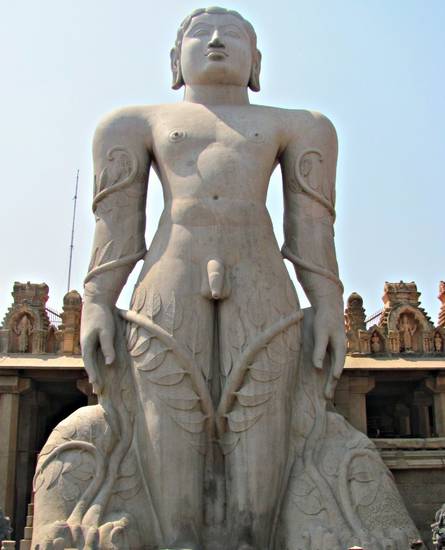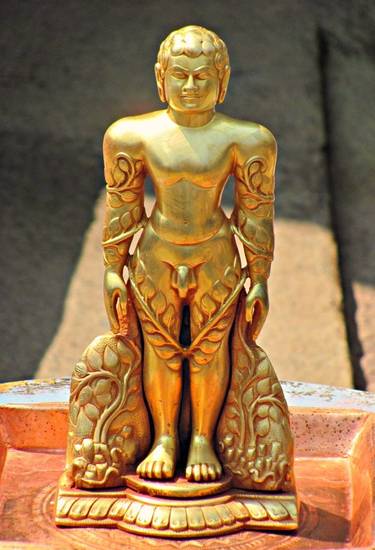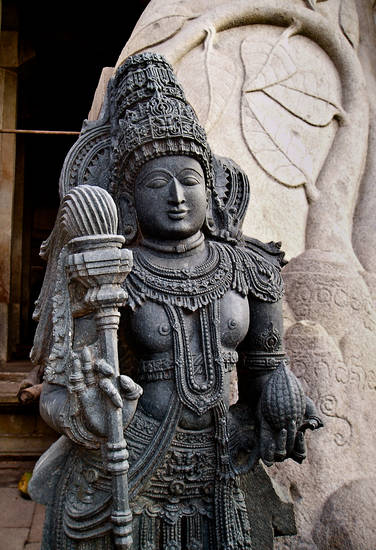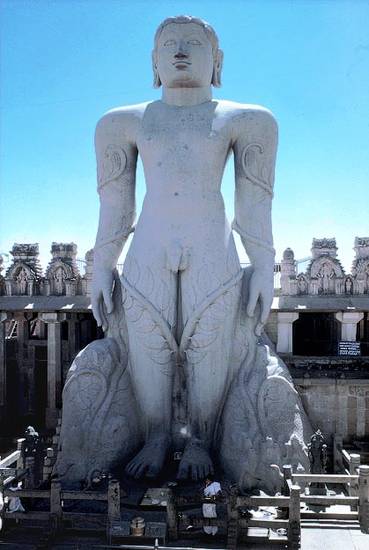Article: Bāhubali
Though not a Jina, Bāhubali is worshipped as a great saint, especially among Digambaras. He has been considered on a par with the Jinas from at least the seventh to eighth centuries, underlined by his representation in art. He transcends all categories.
The story of Bāhubali emphasises the lifelong battle between worldly affairs and passions, and the spiritual values that need to be mastered to reach liberation. A familiar tale to Jains, key episodes have often been illustrated, especially Bāhubali’s year-long meditation.
His fame increased from the tenth century onwards, once a colossal statue was erected on one of the two sacred hills of Shravana Belgola in Karnataka. This distinctive freestanding figure led to many imitations at other shrines, all which attract pilgrims and sightseers. Worship of Bāhubali tends to focus on the spectacular head-anointing rites of these statues but his inspirational life story holds meaning for many contemporary Jains.
Different names
Meaning ‘strong with his arms’ in Sanskrit, the name Bāhubali underlines the heroic nature of the character, referring to one episode in his life. Two other names – Dorbali and Bhujabali – have the same meaning.
The names Manmatha or Kāma-deva are also sometimes given to Bāhubali. Normally referring to the god of love, they are meant to emphasise his beauty.
In Karnataka, a popular designation used from the 12th century onwards is Gommaṭa and its variant forms. The meaning and origins of this name have been much debated but no agreement has been reached. The name Gommaṭeśvara – ‘Lord of Gommaṭa’ – is given to the colossal statue standing on the top of Vindhya-giri at Shravana Belgola. It is said to refer to Cāmuṇḍarāya, the general-minister who caused the statue to be erected, who was also known as Gommaṭa.
Origins
Bāhubali is a legendary saint of the Jains. He cannot be placed in any category of Jain Universal History because he is neither a Jina nor a universal monarch and nor does he belong to any other group.
However, he is associated with two prominent figures in these first two types because he is:
- one of the hundred sons of Ṛṣabhanātha or Lord Ṛṣabha, the first Jina of this era
- the younger half-brother of Bharata, the first universal monarch of this era of time.
Ṛṣabha had two wives, Sumangalā and Sunandā. Sumangalā had Bharata while Sunandā gave birth to Bāhubali. The dispute between half-brothers over who inherits their father’s throne is a motif behind many conflicts described in Indian epics. The story of Bharata and Bāhubali is a Jain expression of this clash.
Literary sources
The life of Bāhubali is told in numerous literary works written in all the languages Jains have used, including Prakrit, Sanskrit, Kannada and Hindi. Whether epics or devotional poems dedicated to him alone, or as part of the tales of his father or half-brother, these stories glorify him and contribute to the growth of his legend. In particular, Bāhubali can be considered a hero of Karnatakan literature, whose life became a subject for prominent writers in the Kannada language (see Settar 1981).
The earliest elaborate account of Bāhubali’s life is found in Jinasena’s Ādi-purāṇa, written in Sanskrit in the ninth century in South India (see pages 208 to 244 of Strohl’s 1990 English translation). This is a seminal work, which subsequent writers from Karnataka used as the main source for their Jain epics.
|
Title |
Author |
Date |
|---|---|---|
|
Ādipurāṇa – Legend of the first Jina |
Pampa |
tenth century |
|
Triṣaṣṭi-lakṣaṇa-mahā-purāṇa – Great Epic of the 63 Illustrious Men |
Cāvuṇḍarāya |
tenth century |
|
Pūrva-purāṇa – Epic of the Early Times |
Hastimalla |
13th century |
|
Bharateśa-vibhava – Power of Lord Bharata |
Ratnakaravarṇi |
16th century |
Hymns and poems on the life of Bāhubali are too numerous to list. The most remarkable ones are:
- Gommaṭa-stuti – Hymn to Gommaṭa – by Boppaṇa-Paṇḍita in 1180
- Bāhubali-carite – Story of Bāhubali – by Doḍḍayya in 1550.
A third category of works dealing with Bāhubali are those linked with sacred places or specific images that are erected. These arise from the tenth century onwards.
Although Bāhubali is of outstanding importance for Digambaras, he should not be seen as sectarian property. He belongs to the common heritage of the Jains. Śvetāmbara sources also narrate his life, especially those detailing Jain Universal History. A representative of this trend is Hemacandra’s epic, the Triṣaṣṭi-śalākā-puruṣa-caritra – Lives of the 63 Illustrious Men – where Bāhubali’s career is depicted in the section on his father, Ṛṣabhanātha or Lord Ṛṣabha.
Key episodes in Bāhubali’s life
Bāhubali’s life is closely connected with those of his father and his half-brother Bharata. Tales of their lives therefore contain information about him.
Bharata and Bāhubali
When King Ṛṣabha renounced worldly life he appointed his eldest son Bharata as his successor, and shared the kingdom among all his other sons. Each of the men thus had his own realm.
Bharata received the special weapon of a universal emperor – cakravartin. To be true to his name, a universal emperor has to conquer all the parts of the entire world. He does this systematically in a progressive process known as dig-vijaya – ‘conquest of the cardinal points’. This entails making war on and overcoming various kingdoms in turn. In Bharata’s case, this meant conquering the kingdoms where his brothers reigned.
One by one, the sons of Ṛṣabha renounced the world and thus ceded their territories to Bharata. But Bāhubali was different from the others and very powerful. After Bharata had gained all the other territories and was recognised as the universal emperor, Bāhubali refused to submit to his authority because Bharata had not conquered him.
There are two main scenarios outlined in different versions of the story.
First scenario
All negotiations failed so preparations for war began. Both kings and armies marched towards each other to wage war, which is described at length in many versions. Before fighting, each of them is said to have paid homage to Ṛṣabhanātha or Lord Ṛṣabha, their father.
The next step is the duel between Bharata and Bāhubali. There are different versions of this episode.
In the first, before striking the fatal blow, Bāhubali realised that wealth and kingship were meaningless if his brother were no more. He stayed the hand holding his weapon.
In the second version Bāhubali and his half-brother fought on. Bāhubali struck Bharata but, seeing that this blow could be fatal, he helped him regain consciousness. The fight, however, continued with more intensity, as Bharata struck again. But Bāhubali suddenly froze as his hand was raised to strike again, when he realised that a fight against one’s brother for a mere kingdom is pointless.
Now the embodiment of tranquility, Bāhubali decides to become a wandering mendicant. Bharata is so awed by this behaviour that he also decides to renounce worldly life.
This scenario is the one described in Johnson’s translation of Hemacandra’s epic.
Second scenario
After listening to advice persuading them not to cause large-scale bloodshed, the two kings engage in a duel. This takes place in three stages:
- ‘encounter of sight’ – dṛṣṭi-yuddha
- ‘encounter in water’ – jala-yuddha
- ‘wrestlers’ encounter’ – malla-yuddha.
In the first duel Bāhubali’s face remains motionless and undisturbed, whereas Bharata is disturbed for a moment. Bāhubali is declared victorious.
In the second part, Bāhubali moves at ease in the pond where the fight takes place while Bharata cannot face water splashes and has to turn his face aside.
In the final stage, the brothers have a classical wrestling match, which Bāhubali wins easily.
As universal emperor, Bharata has the special weapon of the disc – cakra. When he launches this at Bāhubali the disc neither reaches nor strikes him.
After his victory, Bāhubali announces his decision to give up worldly life.
This scenario is the one followed by, for instance, Settar 1981 (page 49) and Strohl 1990 (234).
Rejection of worldly life and the body
Having thus renounced battle and worldly life, Bāhubali stands in kāyotsarga, the ascetic posture of meditation meaning ‘rejection of the body’, with arms hanging down.
Devoted to meditation[,] his eyes fixed on the end of his nose, motionless, the muni appeared like a sign-post. Like a forest-tree his body endured the wind in the hot season spreading hot grains of sand like grains of fire. Plunged in the nectar of good meditation, he was unconscious of the sun in the middle of the hot season, like a fire-pit, over his head. Covered from head to foot with mud made from dust and perspiration caused by the heat, he looked like a boar that had come out of mud. In the rainy-season he was no more disturbed by streams of water than a mountain by trees shaken by wind and rain. He was not shaken from kāyotsarga nor from meditation by the flashes of lightning nor by the mountain-peaks shaken by thunder-storms. Both of his feet were covered with moss caused by dripping water, like the steps of a deserted village-tank [= reservoir]. In the winter season in which elephant-deep streams were frozen, he remained comfortable from the fire of meditation active in burning the fuel of karma. On winter nights when trees were frozen by cold, Bāhubali’s pious meditation bloomed especially, like jasmines. Forest-buffaloes scratched themselves on him just as [though he were] the trunk of a huge tree. […] He was surrounded completely by creepers with a hundred branches shooting up, like a drum by leather thongs. Dense clusters of reeds grew up and around him […]. Abundant darbha-grass filled with moving centipedes grew up around his feet[,] buried in the mud of the rainy season. Hawks, sparrows, etc. […] made nests on his body [which was] covered with creepers. Thousands of serpents hid in the thickets of [the] creepers, terrified by the call of forest peacocks. Bāhubali looked as if he had a thousand arms [created] from [the many] hanging serpents fastened to his body. His feet were surrounded by serpents, like anklets, that had left the ant-hill near his feet.
Johnson’s translation of Hemacandra’s account
pages 324 to 325
This is just one instance of the graphic depiction of the posture that has become associated for ever with Bāhubali.
Omniscience, Brāhmī and Sundarī
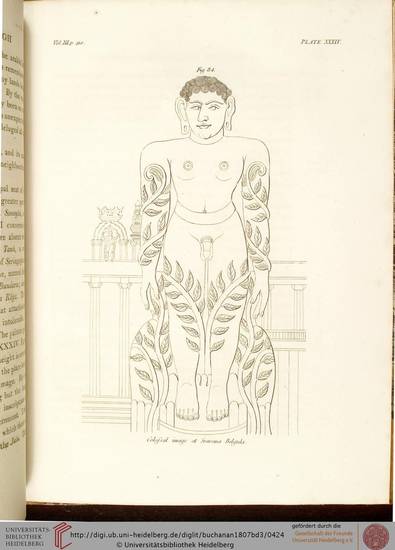
Buchanan’s sketch of Bāhubali
Image by © Heidelberg University Library
Bāhubali’s meditation lasted one year. It resulted in the destruction of many karmas. The next stage to reaching liberation was to overcome his passions, especially pride. Bāhubali’s main characteristic, his pride prevented him from reaching omniscience.
His half-sister Brāhmī and Sundarī, his full sister, had become disciples of their father Ṛṣabhanātha or Lord Ṛṣabha. They were sent to Bāhubali to give him a helpful hint: “Kevala[-jñāna] cannot arise in those seated on an elephant’s shoulder.”
After some time Bāhubali understood this statement, enigmatic though it was. He was proud because he did not show respect to his younger brothers, even though they had become mendicants earlier than he and were therefore worthy of his homage. Realising this, he made a spiritual step and reached omniscience.
Two goddesses
In the Digambara tradition, Brāhmī and Sundarī are not credited with any role in Bāhubali’s enlightenment.
Yet two female characters play a part. They are goddesses or, according to some sources, vidyā-dharīs – goddesses who believe Jain teaching and thus have various magical powers. They intervene to remove the creepers that climb all over Bāhubali’s body.
Final liberation
According to Digambaras, Bāhubali was the first person to attain final liberation in our era.
However, the Śvetāmbaras say that Marudevī, mother of Ṛṣabhanātha or Lord Ṛṣabha, and thus Bāhubali’s grandmother, was the first to be liberated. She achieved this while riding an elephant to hear Ṛṣabha preach to the universal gathering.
Images of Bāhubali
The strong presence in art of Bāhubali can be detected as early as the sixth century. Stone sculptures of him are found all over south India and Deccan, in the modern states of Karnataka, Tamil Nadu, Kerala and Maharashtra. Examples include:
- Cave IV at Bādāmi
- the Meena Basti at Aihole
- ninth-century images at the Ellora caves.
As might be expected, Bāhubali is always shown in art in the characteristic posture of kāyotsarga. Usually naked, he is depicted either alone or flanked by two female characters. Depending on whether the monument is Śvetāmbara or Digambara, these women are identified as either his two sisters or two goddesses.
Many Bāhubali idols are carved from stone but metal images are frequently seen. Created in varying sizes, they are often found in Digambara temples, along with brass images of Jinas and Jain deities.
The battle between Bāhubali and Bharata is the subject of many paintings, such as those in illustrated manuscripts of the Digambara epics, Ādi-purāṇa and Mahāpurāṇa (Doshi 1981, 1985). Less frequently, the battle scene is found in Śvetāmbara Kalpa-sūtra manuscripts.
A unique depiction of Bāhubali is a painted wooden manuscript cover featuring the battle between the half-brothers, as well as Bāhubali’s austerities (see Jain in Doshi 1981: colour plate 1).
Bāhubali’s near-equivalent status to the Jinas is occasionally illustrated by the following signs in art, when the image:
- is underneath the triple parasol, which is a royal insignia
- has god-like figures on each side, similar to the yakṣa and yakṣī flanking the Jinas
- sometimes appears in triple images known as tri-tīrthika, where he is shown along with two Jinas – for example, in Ellora Bāhubali stands near Pārśvanātha or Lord Pārśva, the 23rd Jina.
Reading
- Śravaṇa Beḷgoḷa: an illustrated study
Shadakshari Settar - Rūvāri; Dharwad, Karnataka, India; 1981
- The Image of the Hero in Jainism: Rsabha, Bharata and Bahubali in the Adipurana of Jinasena
George Ralph Strohl - PhD dissertation submitted to University of Chicago in 1984
- ‘The story of Bhārata and Bāhubali: from the Ādipurāṇa’
George Ralph Strohl - The Clever Adulteress and Other Stories: A Treasury of Jain Literature
edited by Phyllis Granoff
Mosaic Press; Oakville, Ontario, Canada; New York, USA; London, UK; 1990
- Historical Dictionary of Jainism
Kristi L. Wiley - Historical Dictionaries of Religions, Philosophies, and Movements series; series editor Jon Woronoff; volume 53
Scarecrow Press; Maryland, USA; 2004
Links
- Images of Bāhubali
-
The Digital South Asia Library at the University of Chicago provides detailed information about the images of Bāhubali found at historical sites in:
- Karnataka – Aihole, Bādāmi, Hallur, Kārkala and Mudabidri
- Uttar Pradesh – Banpur.
The black-and-white photographs can be enlarged by clicking on them.
http://dsal.uchicago.edu/cgi-bin/aiis/aiis_query.py?start_hit=1&keyword=+Bahubali&location=&date=
- Bāhubali statue details
-
Details of the colossus of the great saint Bāhubali at Shravana Belgola shown in this 2009 YouTube video. The serene expression of the naked statue and the plants growing round his body can be clearly seen. The granite figure, showing Bāhubali deep in meditation, has attracted countless pilgrims since its dedication in 981. Most are Digambara Jains, though Bāhubali is revered by all sects.
- Head of Bāhubali colossus
-
The Huntington Archive at Ohio State University provides this photograph of the head of the colossal statue of Bāhubali at Shravana Belgola in Karnataka. Completed in the tenth century, the granite statue has a serene expression and elongated earlobes, reminders that Bāhubali gave up his rank as king – who wore heavy jewellery, including earrings – to seek spiritual truth. Pilgrims climb the steep hill to worship at the feet of the idol, which is nearly 18 metres tall.
http://huntington.wmc.ohio-state.edu/public/index.cfm?fuseaction=showThisDetail&ObjectID=30021935
- Dharmasthala Bāhubali
-
A large statue of Bāhubali is found at the Hindu pilgrimage site at Dharmasthala in Karnataka. The temple management of the Sri Manjunatha Swamy Temple provides information about the story of Bāhubali and Bharata and the history of the statue at the site.
https://www.shridharmasthala.org/2020/02/05/bhagwan-bahubali-paadabhisheka/
- +
- aAbhavya
- aAbhinandana
- aAbhiṣeka
- aĀcāra
- aĀcārāṅga-sūtra
- aĀcārya
- aAchalbhrata
- aAḍhāī-dvīpa
- aAdharma
- aAdho-loka
- aAdhyayana
- aAdvaita Vedānta
- aĀgama
- aAghātīya
- aAghātīya-karman
- aAgnibhuti
- aAgra
- aĀhāra
- aAhiṃsā
- aAhimsa Day
- aAjita
- aAjīva
- aAkampit
- aĀkāśa
- aAkbar the Great
- aAkṣaya-tṛtīyā
- aAlauddin Khalji
- aAlbert Einstein
- aAllah
- aAlms
- aĀlocanā
- aAloka-ākāśa
- aAmāri
- aAmbikā or Kūṣmāṇḍinī
- aAnagāra
- aAnanta
- aAnarthadaṇḍa
- aAnaśana
- aAnekānta-vāda
- aAṅga
- aAniconism
- aAnojjā
- aAntarāla
- aAntarāya-karma
- aAṇu
- aAṇu-vrata
- aAnukampā
- aAnuprekṣā
- aAnusvāra
- aApabhraṃśa
- aAparigraha
- aAra
- aĀrambha
- aĀrambhaja
- aĀratī
- aArdhamāgadhī Prākrit
- aArhaṃ
- aArhat
- aArśana-āvaraṇīya-karma
- aĀrta-dhyāna
- aĀryikā
- aĀryikā Jñānamati
- aĀśātanā
- aĀścarya
- aAscetic
- aAsceticism
- aAshram
- aAspiration
- aĀsrava
- aAṣṭa-maṅgala
- aAṣṭāpada
- aAstikāya
- aAstrolabe
- aAsura
- aAtheism
- aAticāra
- aAtiśayakṣetra
- aAtithisaṃvibhāgavrata
- aĀtma-vāda
- aĀtman
- aAuṃ
- aAurangzeb
- aAuspicious
- aAusterity
- aAvadhāna
- aAvadhi-jñāna
- aĀvaraṇī-yakarman
- aAvasarpiṇī
- aAvatāra
- aAvidyā
- aAxiom
- aĀyāga-paṭa
- aĀyambil
- aĀyu-karma
- aĀyurveda
- bBabur
- bBāhubali
- bBaladeva
- bBālāvabodha
- bBandha
- bBasadi
- bBazaar
- bBhadrankarvijay
- bBhagavant
- bBhaktāmara-stotra
- bBhakti
- bBhale
- bBharata
- bBhāṣā
- bBhāṣya
- bBhaṭṭāraka
- bBhāva
- bBhāva-pūjā
- bBhāvanā
- bBhavana-vāsin
- bBhavya
- bBhavyatva
- bBhaya
- bBhoga-bhūmi
- bBhogopabhoga
- bBodhi
- bBollywood
- bBrahmā
- bBrahma-deva
- bBrahmacārī
- bBrāhmaṇa
- bBraj Bhāṣā
- bBright fortnight
- bBritish Raj
- bBuddha
- bBuddhi-sagar
- bBuddhism
- bBuddhist
- cCaitya
- cCaityavāsin
- cCakravartin
- cCakreśvarī
- cCāmara
- cCandanā
- cCandragupta
- cCandraprabha
- cCanon
- cCāritra
- cCāritramohanīya-karman
- cCarũrī
- cCaste
- cCaturvidha-saṅgha
- cCaturviṃśati-stava
- cCāturyāma
- cCE
- cCelibacy
- cCha
- cChadmastha
- cChastity
- cCheda-sūtra
- cChristian
- cChristianity
- cClergy
- cCloning
- cColophon
- cCommentary
- cConch
- cConfession
- cCongregation
- cConsecration
- cCosmology
- cCremation
- cCrore
- cCult
- cCūrṇi
- dDādā-guru
- dDalit
- dDāna
- dDaṇḍa
- dDark fortnight
- dDarśana
- dDarśanamohanī-yakarman
- dDaśa-lakṣaṇa-parvan
- dDeity
- dDelhi Sultanate
- dDerāsar
- dDeśāvakāśika-vrata
- dDetachment
- dDevanāgarī
- dDevānandā
- dDevarddhi-gani
- dDevotee
- dDhamal
- dDhanuṣ
- dDhāra
- dDharma
- dDharma-dhyāna
- dDharma-sāgara
- dDharmastikaya
- dDhātakīkhaṇḍa
- dDholak
- dDhyāna
- dDiaspora
- dDig-vrata
- dDigambara
- dDīkṣā
- dDisciple
- dDīvālī
- dDivya-dhvani
- dDNA
- dDoctrine
- dDogma
- dDonor
- dDoṣa
- dDravya
- dDravya-pūjā
- dDrone
- dDuṣamā
- dDuṣamā-duṣamā
- dDuṣamā-suṣamā
- dDveṣa
- dDvīpa
- eEast India Company
- eEightfold Path
- eEkānta-vāda
- eEkendriya
- eElder
- eElders
- eEschatology
- eEtc up to
- fFarmān
- fFast
- fFatehpur Sikri
- fFestival
- fFestschrift
- fFiruz Shah
- fFly-Whisks
- fFolio
- fFour Noble Truths
- gGaccha
- gGaṇa
- gGaṇadhara
- gGanadharavada
- gGaṇeśa
- gGaṇin
- gGarba
- gGarbha
- gGarbha-gṛha
- gGaruḍa
- gGati
- gGene
- gGenomics
- gGhātī-yakarman
- gGhātīya
- gGhaznavid
- gGhiyasuddin Tughlaq
- gGhurid
- gGloss
- gGotra-karma
- gGujarāt
- gGujarati
- gGuṇa
- gGuṇa-sthāna
- gGuṇa-vrata
- gGupti
- gGuru
- gGuruṇī
- hHagiography
- hHajj
- hHaṃsa
- hHaribhadra
- hHariṇaigameṣin
- hHasta
- hHeresy
- hHiṃsā
- hHindi
- hHindu
- hHinduism
- hHīravijaya
- hHoroscope
- hHrīṃ
- hHumayun
- hHymn
- iIconoclasm
- iIconography
- iIdol
- iIndian Independence
- iIndology
- iIndra
- iIndrabhūti Gautama
- iIndriya
- iInitiation
- iIntercession
- iInvocation
- iIQ
- iIslam
- iIslamicate
- iIṣṭadevatā
- iĪśvara
- jJagat
- jJahangir
- jJain
- jJaina Devanāgarī
- jJaina Śaurasenī
- jJaina-dharma
- jJainaśāsana
- jJainness
- jJaisalmer
- jJamāli
- jJambū-dvīpa
- jJames Burgess
- jJanma
- jJanma-kalyāṇa
- jJarā
- jJāti
- jJina
- jJina-āgama
- jJina-bhavana
- jJina-bimba
- jJina-mātā
- jJinacandra-sūri
- jJinadatta
- jJinaprabha
- jJīva
- jJñāna
- jJñāna-āvaraṇīya-karma
- jJñāna-āvarṇiya
- jJñānsundar
- jJyotiṣka
- kKāla
- kKālakācārya-kathā
- kKālidāsa
- kKalpa-sūtra
- kKalpa-vṛkṣa
- kKalyāṇaka
- kKalyanvijay
- kKamaṇḍalu
- kKamaṭha
- kKarma
- kKarma-bhūmi
- kKarma-grantha
- kKarma-prakṛti
- kKarma-vāda
- kKarmon
- kKarnataka
- kKaṣāya
- kKathā
- kKāvya
- kKāya
- kKāyotsarga
- kKeśa-loca
- kKetu
- kKevala-jñāna
- kKevalin
- kKhalji
- kKharatara-gaccha
- kKnowledge
- kKriyā
- kKriyā-vāda
- kKṛṣṇa
- kKṣamā-śramaṇa
- kKṣapakaśreṇi
- kKṣatriya
- kKṣullaka
- kKulakara
- kKundakunda
- kKunthu
- lLabdhi
- lLaity
- lLakh
- lLāñchana
- lLands of Action
- lLaukāntika
- lLavaṇa-samudra
- lLeśyā
- lLiṅga
- lLinguistics
- lLoka
- lLoka-ākāśa
- lLoka-puruṣa
- lLoka-vāda
- lLotus
- lLotus lake
- mMadhya-loka
- mMahā-videha
- mMahā-vrata
- mMahābhārata
- mMahāmastakābhiṣeka
- mMāhārāṣṭra
- mMāhārāṣṭrī Prākrit
- mMahattarā Yākinī
- mMahāvīr Jayantī
- mMahāvīra
- mMakāra
- mMakkhali Gośāla
- mMalli
- mMāna-stambha
- mManaḥ-paryāya-jñāna
- mMaṇḍala
- mMaṇḍapa
- mMandit
- mMaṅgala
- mMantra
- mMantras
- mManuṣya-loka
- mMarāṭhī
- mMārgaṇā
- mMartyr
- mMarudevī
- mMaṭha
- mMati-jñāna
- mMauryaputra
- mMecca
- mMendicant lineage
- mMetarya
- mMiracle
- mMithyādṛṣṭi
- mMohandas Gandhi
- mMohanīya-karma
- mMokṣa
- mMonastic order
- mMonasticism
- mMonk
- mMonotheism
- mMosque
- mMount Meru
- mMount Sammeta
- mMṛgāvatī
- mMughal
- mMuhammad
- mMuhammad bin Tughlaq
- mMuhpattī
- mMūla-sūtra
- mMūlaguṇa
- mMumbaī
- mMuni
- mMunisuvrata
- mMurad Bakhsh
- mMūrti-pūjaka
- mMuslim
- mMysticism
- nNābhi
- nNāga-kal
- nNāgapurīya Tapā-gaccha
- nNāgarī
- nNāma-karma
- nNamaskāra-mantra
- nNami
- nNandīśvara-dvīpa
- nNandivardhana
- nNandyāvarta
- nNāraka
- nNāraki
- nNasalisation
- nNātha
- nNavrātrī
- nNaya-vāda
- nNemi
- nNidāna
- nniggaṃthāṇa vā 2
- nniggaṃtho vā 2
- nNigoda
- nNihnava
- nNikṣepa
- nNirgrantha
- nNirjarā
- nNirvāṇa
- nNiryukti
- nNiṣidhi
- nNitya
- nNiyati
- nNo-kaṣāya
- nNudity
- nNun
- oOcean of milk
- oOmniscience
- oOrdination
- ppa°
- pPadmaprabha
- pPadmāsana
- pPadmāvatī
- pPādukā
- pPalanquin
- pPalette
- pPañca-muṣṭi
- pPāṇḍava
- pPaṇḍit
- pPandit Dalsukh D. Malvania
- pPandit Sukhlalji
- pPāṇipātra
- pPāpa
- pParamātman
- pParameṣṭhin
- pPāraṇā
- pParigraha
- pPariṇāma
- pParīṣaha
- pParokṣa
- pPārśva
- pPārśvanātha
- pParyāya
- pParyuṣaṇ
- pPaṭa
- pPatan
- pPātra
- pPenance
- pPersian
- pPhala
- pPhilology
- pPicchikā
- pPilgrimage
- pPīr
- pPolymath
- pPoṣadha
- pPossession
- pPothī
- pPrabhas
- pPradakṣiṇā
- pPradeśa
- pPrākāra
- pPrakīrṇaka-sūtra
- pPrākrit
- pPramāda
- pPramukhā
- pPrati-vāsudeva
- pPratikramaṇa
- pPratimā
- pPratiṣṭhā
- pPratyākhyāna
- pPratyakṣa
- pPravacana
- pPrāyaścitta
- pPrayer
- pPre-modern
- pPreach
- pPredestination
- pProtestant
- pProvenance
- pPudgala
- pPūjā
- pPujārī
- pPukharavara-dvīpa
- pPuṇya
- pPūrva
- pPuṣkara-dvīpa
- pPuṣpadanta
- pPyre
- qQur’an
- rRāga
- rRāhu
- rRainy season
- rRajasthan
- rRajasthani
- rRājimatī
- rRajoharaṇa
- rRajput
- rRāma
- rRāmāyaṇa
- rRangoli
- rRās-garbā
- rRasa
- rRathanemi
- rRatna-traya
- rRātri-bhojana
- rRaudra-dhyāna
- rRecto
- rRelic
- rRenunciation
- rRetroflex
- rRevatī
- %Ṛg-veda
- rRite
- rRosary
- %Ṛṣabha
- %Ṛṣabhanātha
- rRupee
- sSaciyā Mātā
- sSādhu
- sSādhvī
- sSāgāra
- sSaint
- sŚaivaism
- sŚaka-saṃvat
- sSallekhanā
- sŚalya
- sSamacatuṣṭha
- sSamādhimaraṇa
- sSamaṇi
- sSāmarambha
- sSamavasaraṇa
- sSāmāyika
- sSaṃbhava
- sSamiti
- sSaṃjñā
- sSaṃkalpaja
- sSaṃsāra
- sSamudghāta
- sSaṃvara
- sSaṃvega
- sSamyak-cāritra
- sSamyak-darśana
- sSamyak-jñāna
- sSamyaktva
- sSaṃyama
- sSanctuary
- sSandalwood
- sSaṇgha
- sSanskrit
- sSant
- sŚānti
- sSapta-bhaṅgi-naya
- sSārambha
- sSarasvatī
- sSarvajña
- sSāsan-devi
- sŚāsana-devatā
- sŚāstra
- %Ṣaṭ-jīvanikāya
- sSatī
- sSatīmātā
- sSatya
- sSchism
- sScribe
- sScripture
- sSect
- sSecularism
- sŚenāī
- sSermon
- sŚeṣavatī
- sSevā
- sSeven fields of donation
- sShah Jahan
- sShantidas Jhaveri
- sShrine
- sSiddha
- sSiddha-śilā
- sSiddhacakra or Navadevatā
- sSiddhānta
- sSiddhārtha
- sSiddhi
- sSikh
- sSikhism
- sŚikṣā-vrata
- sŚīla
- sSin
- sSindh
- sŚītala
- sŚiva
- sSkandha
- sSomanatha
- sŚraddhā
- sŚramaṇa
- sŚrāvaka
- sŚrāvakācāra
- sŚrāvikā
- sŚreyāṃsa
- sŚrī
- sŚrīvatsa
- sŚruta-jñāna
- sŚruta-pañcamī
- sSthānaka-vāsin
- sSthāpanācārya
- sSthāvara
- sSthavira
- sSthiti
- sStrīmukti
- sStūpa
- sSubcontinent
- sSudarshana
- sŚuddhi
- sSudharma
- sŚūdra
- sSufism
- sSukha
- sŚukla-dhyāna
- sSulasā
- sSultan
- sSumati
- sSundarśrī
- sSupārśva
- sSūri
- sSuṣamā
- sSuṣamā-duṣamā
- sSuṣamā-suṣamā
- sSūtra
- sSuyam me ausam! Tenam bhagavaya evamakkhayam
- sSvādhyāya
- sSvāhā
- sSvastika
- sŚvetāmbara
- sŚvetāmbara Terāpanthin
- sŚvetāmbaras
- sSwan
- sSyād-vāda
- tTabla
- tTantra
- tTapā-gaccha
- tTapas
- tTāraṇ Svāmī Panth
- tTattva
- tTattvārtha-sūtra
- tTemple
- tTemple-city
- tThe Enlightenment
- tTheology
- tThree worlds
- %Ṭīkā
- tTilaka
- tTīrtha
- tTīrthaṃkaranāma-karman
- tTīrthankara
- tTransliteration
- tTrasa
- tTrasa-nāḍī
- tTriśalā
- tTriṣaṣṭi-śalākā-puruṣa-caritra
- tTti bemi
- tTughlaq
- tTunk
- uUdumbara
- uUniversal History
- uUpādhyāya
- uUpāṅga
- uUpaniṣads
- uUpāsaka
- uUpasarga
- uUpāśraya
- uŪrdhva-loka
- uUtsarpiṇī
- uUttarādhyayana-sūtra
- vVāhana
- vVaimānika
- vVairāgya
- vVaiṣṇava
- vVaiśramaṇa
- vVaiśya
- vValabhī
- vVanaspatikāya
- vVandana
- vVaṇik
- vVarṇa
- vVāsudeva
- vVāsupūjya
- vVayubhūti
- vVeda
- vVedanīya-karma
- vVegetarianism
- vVehicle
- vVernacular
- vVerso
- vVidyā
- vVidyā-devī
- vVihāra
- vVijñapti-patra
- vVikrama-saṃvat
- vVikṛti
- vVimala
- vVinaya
- vVipāka
- vVirji Vora
- vVirodhaja
- vVīrya
- vVisarga
- vViṣṇu
- vVītarāga
- vVizier
- vVotive
- vVow
- vVrata
- vVS
- vVyakta
- vVyantara
- vVyasana
- yYakṣa
- yYakṣī
- yYantra
- yYaśoda
- yYaśovijaya
- yYati
- yYātrā
- yYoga
- yYoginī
- yYojana


